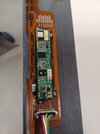Crash_Test_Pilot
New Member
Some of the newer business jets have electronic window shades. It's a neat concept, but they stop working all the time and the cost to get one replaced is ridiculous. I'm trying to figure out how to repair.
Everything mechanical is pretty simple, but there's a circuit board that I'm worried is failing. I sent off to a circuit board repair company and they said they couldn't repair because, "it appears most of the components are programmed chips which we cannot support."
I've attached a couple of pictures for review. Here's my question - can anyone repair a circuit board with programmed chips (without having the program)?
Everything mechanical is pretty simple, but there's a circuit board that I'm worried is failing. I sent off to a circuit board repair company and they said they couldn't repair because, "it appears most of the components are programmed chips which we cannot support."
I've attached a couple of pictures for review. Here's my question - can anyone repair a circuit board with programmed chips (without having the program)?




